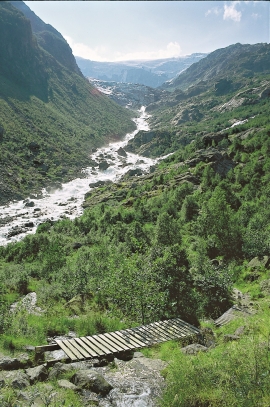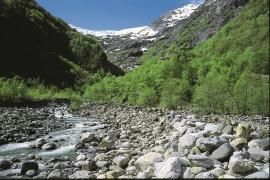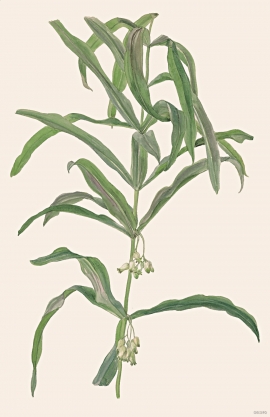Published: 06.09.2015 | Author: Atle Nesje, Bjørn Moe
Buardalen and Buarbreen before 1880. The hotel that is visible in the centre of the picture was destroyed when the ice advanced a few years after the picture was taken. (Knud Knudsen)
TOURIST GLACIER IN INNER HARDANGER
Buarbreen glacier was one of the first destinations during the period of increasing tourism in Odda in the 1800s. Foreigners came by the thousands, mostly Englishmen and Germans, to the magnificent landscape in front of the glacier. Back at the hotel in Odda they could enjoy drinks containing ice from the glacier.
Together with the Bondhusbreen in Kvinnherad the Buarbreen glacier is the glacial tongue from Foglefonna that has extended furthest down the valley side, and which has been the most easily accessible. The Buarbreen glacier is divided into two arms, Øvre (Upper) and Nedre (Lower) Buarbreen. From the parking lot innermost in Buardalen it is a two hour walk to the glacier tongue. Along the way, traces are visible in the landscape and vegetation of how the glacier has grown and shrunk from the end of the 1800s until today.
The biggest period of growth was during "The Little Ice Age", a time of glacial advance that lasted from about 1650 until 1930. Pictures taken by Knud Knudsen at the beginning of the 1860s and up until 1892 show that Buarbreen advanced very much forward during this time. In a photo from 1892 the front of the glacier reaches right up to an old house. The glacier is believed to have reached its maximum extent in 1893, a whole two kilometres further than today. A photograph taken by Johan Rekstad in 1917 shows that the Buarbreen glacier had by then receded about 600 metres relative to its maximum position in the 1890s. A new major advance in the 1930s deposited new side- and end moraines about 50 metres inward of the 1893-moraine.
After the glacial advance of the 1920s and 1930s, the Buarbreen glacier receded again in the 1960s. Aerial photos show that the glacier had at that time separated into two after having been one large arm during "The Little Ice Age", and that moraine ridges had been deposited after smaller advances, just prior to its receding. The glacier front has had several smaller advances both in the 1960s, 1970s and 1990s. In the period from 1994-96 the Lower Buarbreen glacier advanced 42 metres, as a reaction to increased precipitation in winter.
It was hard times for the forest when the glacier advanced far down into the lowlands. A picture from 1892 shows old pollarded trees that stood right beside the edge of the glacier. We can imagine that many trees and other parts of the forest were engulfed by the glacier as it advanced. Some elm and other warm-loving deciduous trees just managed to escape the glacial advances. There is still a lush, old deciduous forest growing high up on the south-facing slope, that the glacier never touched. Where the glacier covered the ground roughly a hundred years ago, however, new forest has grown up since, except for in fields where there has been much grazing. In the new forest the soil is scanty, because it has not had much time to develop. The most important tree types here are birch and grey alder.
Buardalen valley, which was a magnet for tourists a hundred years ago, is still worth a visit. The glacier can be seen innermost in the valley. (Svein Nord)
Pioneer forest
Birch, willow and grey alder are hardy tree types that can survive right near glaciers. When the ice recedes back, they are quick to colonize the new ground. The first plants that colonize a new growing place are called pioneer plants. Birch, willow and grey alder are typical pioneer trees. Birch and grey alder's requirement for warmth in summer is less than for most other tree species. The pioneer tree tends also to make many seeds, and they grow quickly to begin with. Therefore, they quickly become established in open places where there is not much competition from other types of trees.
On fresh moraine soil the grey alder is helped by bacteria in the tubers on its roots. The bacteria can take up nitrogen from the air and soil. This helps the grey alder to grow in environments that are nutrient-depleted. The grey alder thrives along the rivers and valley bottoms in Buardalen (picture), where the continuously changing water supply is not a problem. But if the conditions become too harsh, with a lot of erosion in the water from the glacier, or if the summer is too short and cold, not even the grey alder can survive. In this case, willow thicket takes over the pioneer role. The most common species then are dark-leaved willow, gray-leaved willow, Lapland willow and tea-leaved willow. (Svein Nord)
- Bjelland, T. Rekonstruksjon av bre- og skredaktivitet i Buerdalen. 1998. Hovudfagsoppg. i naturgeografi, Inst. for geografi. UiB.







